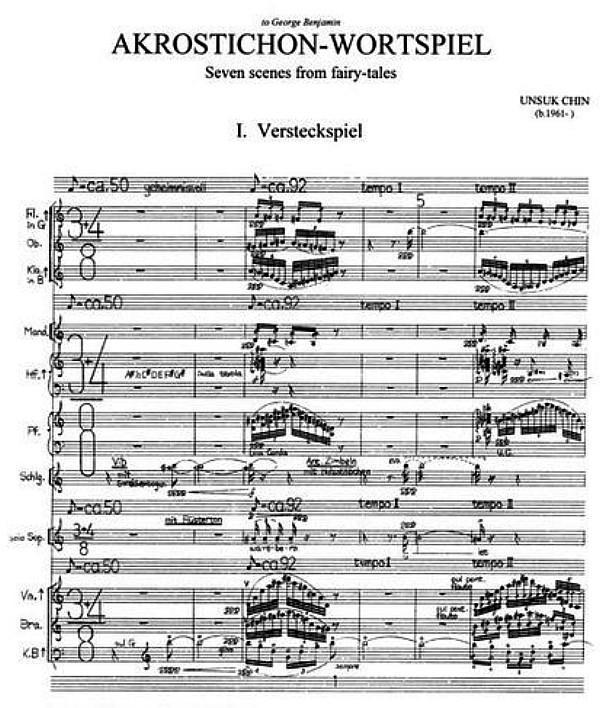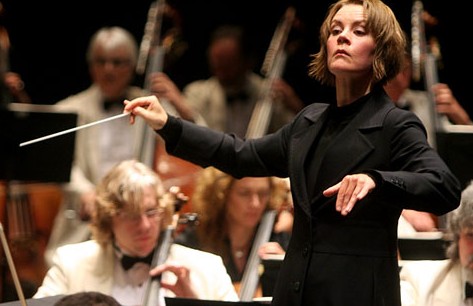T hough some points of contact with the theatrical surrealism of Ligeti’s ‘Aventures/Nouvelles’ might be detected, ‘Akrostichon-Wortspiel’ gives much more emphasis to wit and exuberance than to menace. The third movement, ‘Die Spielregel—strawkcurtieZ’ (Zeitruckwarts - reversed time) is a dazzling scherzo with appropriate palindromic elements. But the most sheerly beautiful music is in the fifth movement, ‘Domifare S’, whose beguilingly repetitive descents are magically offset by the simple device of destabilising a bass line, which is in any case slightly out-of-tune. A similar process is applied to the initially stable, inflected Bs at the start of the last movement.”F or the relatively apolitical Unsuk Chin it is not a question as to how frequently performed or widely noted a piece may become. Instead, what matters most is that it be performed empathetically and be understood, no matter how esoteric its content or intentions.
— Arnold Whitall, Musical Times, 2000.
A nalysis assumes that music is a metaphor for ‘literary’ meaning—analysis aims to clarify relationships, customarily using methods that closely parallel ‘literary’ theory.
A nd the Unsuk Chin piece performed at Lincoln Center last night is nominally ‘literary’. The texts that informed/inspired Akrostichon-Wortspiel come from Michael Ende’s ‘The Endless Story’ and Lewis Carroll’s ‘Alice through the Looking Glass’. The selected texts have been redacted so as to juxtapose consonants and vowels to form novel, surprising patterns. In some places (e.g., Mvt. 3) the letters comprising the words are reversed, playing tricks with the things signified. It is a different sort of fantasy—entirely different from the ‘grotesqueries’ of Ligeti’s ‘Mysteries of the Macabre’, which was the first piece of the program.
Y et, analyzing ‘Akrostichon’ in a ‘literary’ way seems wrong somehow. And why always draw parallels between Unsuk Chin and Ligeti or Lutosławski or others, anyway? To me, seems like a ‘stretch’. Not that resemblances are hard to find; they are not. But the ‘stretch’ has for me more to do with the motivations that seem to underlie the music and why it came to be written. For example, I enjoyed the intensely physical passages in ‘Akrostichon’, where modernist and classical idioms violently oppose each other.
K ommt der öffentliche Druck, das ist sehr schwierig, die Qualität zu halten, die Öffentlichkeit will immer mehr, man versucht die Gunst der Stunde zu nutzen...
[The public pressure... it is very difficult to maintain real quality... the public wants more and more, of whatever is en vogue...].”
— Unsuk Chin, interview with Hanno Ehrler, Berlin, 2008.

[50-sec clip, Ensemble intercontemporain, Unsuk Chin, ‘Akrostichon-Wortspiel’, Mvt. 1, 2.0MB MP3]
T he aggressive passages in the Ligeti pieces on the program are less ‘open-ended’, less ‘exploratory’, more ‘flamboyant’ than Unsuk Chin’s. Maybe it’s a difference that arises because of their different cultures, different ages at the time these respective pieces were composed, different financial and political circumstances at the time, and so on. Surely it could have nothing to do with gender, could it?
W ell, sure, it could! There is a physical vehemence in ‘Akrostichon’—a gendered performativity, along the lines that Judith Butler has written about. It is not a ‘tame’ cross-word. It is intensely physical, not cerebral. This piece, to me, is about beauty-in-vehemence—about women’s right to engage in aggression and vehement action, in violent performative action that involves risk. Inexplicable risk—much like my maternal grandmother who, in the 1920s, was physically boisterous; a honky-tonk piano player in Superior, Wisconsin, among other things; smoked big stogies to the ripe old age of 93… valor on the violent fields brings ‘glory’ to the valiant-violent participants; violence and aggression beget ‘story’ and meaning; risk is essential to creation and story-generation.

C hin’s compositional method seems thoroughly ‘organic’, and more concerned with forging palpable ‘continuity’ than Ligeti may have been in the 1970s and later. Ligeti, by then, had nothing to ‘prove’. Unsuk Chin is, in this piece, showing her discoveries of what needs yet to be proven, physically. The development progresses relatively slowly: the listener has ample time to grasp the emerging textures, orient herself/himself, place things in context, become convinced of what is being ‘shown’ or ‘proven’. In all, this was an absolutely wonderful interpretation by Yeree Suh and members of Ensemble intercontemporain, under Susanna Mälkki’s shrewd-yet-intensely-physical direction. Bravo! (for the entire program, not just the one piece that spawned the comments above)

- Ensemble intercontemporain website
- MusicaReaction blog
- Simon. Ancient and modern. 5:4 blog, 23-SEP-2008.
- Unsuk Chin at Boosey.com
- Susanna Malkki page at HarrisonParrott
- Unsuk Chin interview in U.S. Asians
- Butler J. Gender Trouble: Feminism and the Subversion of Identity. Routledge, 2007.
- Butler J. Undoing Gender. Routledge, 2004.
- Butler J. Excitable Speech: A Politics of the Performative. Routledge, 1993.
- Jantzen G. Foundations of Violence. Routledge, 2004.
- Ensemble intercontemporain. Unsuk Chin. (Deutsche Grammophon, 2005.)
No comments:
Post a Comment